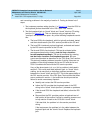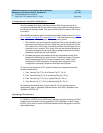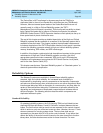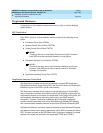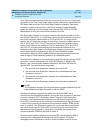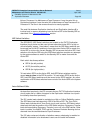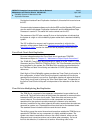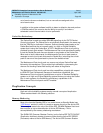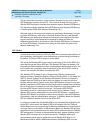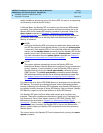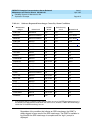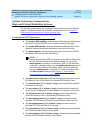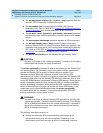
DEFINITY Enterprise Communications Server Release 5
Maintenance and Test for R5vs/si
555-230-123
Issue 1
April 1997
Reliability Systems: A Maintenance Aid
Page 6-7Duplicated Hardware
6
Duplication Interface B and Duplication Interface A; this serial link is carried over
the ICC.
Communication between software on the Active SPE and the Standby SPE is sent
over the serial link between Duplication Interface A and the Maintenance/Tape
Processor in carrier B. This serial link is also carried over the ICC.
The presence of the ICC also causes ID pins on the backplane to indicate that
the system is a high or critical reliability system rather than a standard reliability
system.
The ICC is difficult to connect, and its proper connection is critical to the
operation of the system. Refer to the ‘‘
Procedure for Installing/Replacing the
Inter-Cabinet Cable’’ section for details on how to properly connect the ICC.
Tone-Clock Circuit Pack Duplication
For more information about the Tone-Clock circuit packs see TONE-BD
Maintenance Object in Chapter 10, ‘‘
Maintenance Object Repair Procedures’’.
The TONE-BD (Tone-Clock) MO functionality is made up of the TONE-PT (Tone
Generator) and the TDM-CLK (TDM Bus Clock). The Tone Generator provides all
tones required by the system; the TDM Bus Clock provides synchronization for
the TDM Bus and aids in monitoring and selection of SYNC (Synchronization)
references.
Each High or Critical Reliability system provides two Tone-Clock circuit packs. In
this configuration, a failed Tone-Clock circuit pack is switched off-line and an
operational circuit pack is put on-line. Duplication Interface A selects the Active
Tone-Clock circuit pack by driving the Tone-Clock Select lead. The selection of
the Active Tone-Clock circuit pack is independent of the selection of the Active
SPE.
Time Division Multiplexing Bus Duplication
The TDM Bus is composed of two separate, independent buses called bus A
and bus B. The first five time slots of both buses are reserved for communication
between the SPE and port circuit packs. These time slots are known as the
control channel. The control channel is a vital component and must be
operational for the system to provide meaningful customer voice and data
services. In addition to the control channel time slots, several other time slots are
reserved for system use. These additional time slots are for the standard tones.
The standard tones include the dial tone and the touch tones.
The ability to move the control channel and tones from a defective TDM Bus to an
operational TDM Bus is a key component of a highly-available system. The
system can detect transmission errors on the control channel, errors can be
diagnosed, and corrective actions can be taken when necessary. If a bus is
found to be defective, it is taken out-of-service. All existing calls on the



